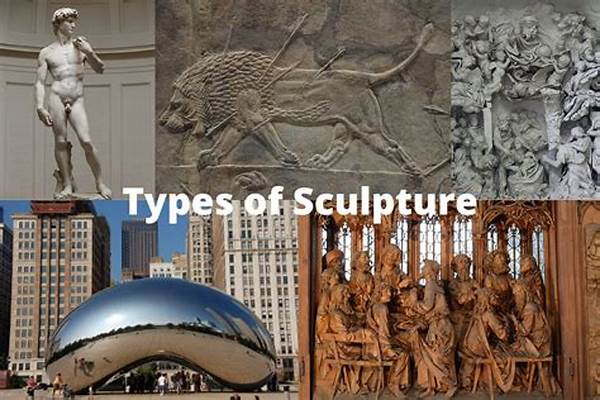Evolution Of Sculpture Materials
Long ago, when time itself felt like an endless river and humankind was just learning to craft their world, a curious fascination took hold. This desire was to shape the unyielding with their hands, to tell stories in the language of form and texture. Thus began the ancient craft of sculpture. The journey from unrefined stones to the cutting-edge materials of today maps a trail of our evolution, revealing much about the minds and societies that walked before us.
Read Now : Public Space Creative Enactments
Ancient Foundations
In the ancient lands where great civilizations rose, so too did the first sculptures. Primitive tools in hand, humans learned that stone, wood, and bone could be coaxed into figures of reverence and utility. The evolution of sculpture materials in this era was one of practical necessity and available resources. Stone, a symbol of permanence, allowed the creation of resilient monuments. Wood offered warmth and ease, though more transient. Bone brought a spiritual connection to the beasts shared among them. This ancient palette told stories of gods and kin, of heroes and the earth itself. Each piece, an echo of the world from which it was hewn.
The Age of Metals
The discovery of metals brought a revolution. Suddenly, sculptors could cast forms with unearthly precision and durability. The glow of bronze and the sheen of iron added a divine allure to human and divine figures alike. The evolution of sculpture materials now spun tales of progress, man’s ascendancy over nature, and his quest for immortality in form. The malleability of metals unlocked new creative expressions, allowing artists to render the delicate curve of a face or the fierce strength of a warrior in unprecedented detail, transforming the very notion of sculpture forever.
Renaissance Revival
As Europe awoke from the Middle Ages, the Renaissance sparked a rebirth of art, learning, and curiosity. This revival was marked by a return to classical ideals, yet the evolution of sculpture materials took center stage. Marble, reborn from the roots of ancient Greece and Rome, became the material of choice. Artists like Michelangelo unlocked its secrets, chiseling life’s essence from cold stone. Textured with passion and precision, sculptures of this period redefined human beauty, capturing the nuanced soul beneath. This era celebrated humanism and nature, blending innovation with echoes of antiquity.
The Industrial Transformation
The dawn of the industrial age heralded vast changes. Artists embraced experimentation, driven by the bounty of the industrial revolution. The evolution of sculpture materials saw the incorporation of cast iron, steel, and new alloys, each expanding the horizon of possibility. With them, sculptors created audacious works that paid homage to burgeoning cities and technological marvels. They explored concepts of abstraction and form, casting aside traditional constraints and redefining what sculpture could represent in this new age of invention and speed.
Modernism and New Frontiers
Modernism swept through the art world, urging a departure from classical methods, further fueling the evolution of sculpture materials. Artists began to incorporate glass, plastics, and composites, pushing the boundaries of form and medium. Sculpture became not just a reflection of the physical but a manifestation of the conceptual, confronting social, political, and philosophical realms. The evolution of sculpture materials was now a dynamic dialogue between substance and idea, celebrating the infinite possibilities of human creativity.
Read Now : Nocturnal Art Appreciation Tours
Digital and Beyond
The digital revolution opened unforeseen dimensions. 3D printing and digital modeling allowed artists to bypass traditional constraints, crafting intricate designs previously thought impossible. The evolution of sculpture materials reached a new frontier, where virtual reality played an active role in creation and presentation. Today’s artists blend ancient techniques with futuristic technology, weaving together stories of both past and future in ever-complex layers. Sculpture has become a medium of boundless exploration, reflecting humanity’s constant thirst for discovery.
The Timeless Dance
The evolution of sculpture materials is not merely a tale of art but a testament to human resilience, ingenuity, and perpetual curiosity. Each material, from humble stone to futuristic composites, represents a chapter in our story—a dance across time and culture. Sculptures stand as timeless testaments to the spirit of creation, shaping our understanding of both the world and ourselves. In this never-ending journey, we find both roots and wings, grounding us in history while propelling us toward the infinite potential of tomorrow’s artistic horizon.
